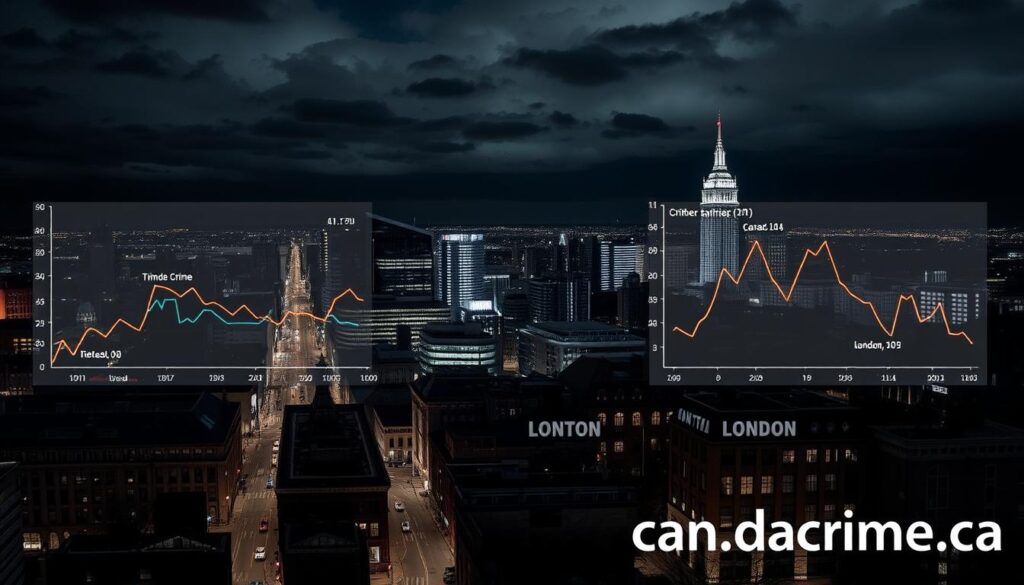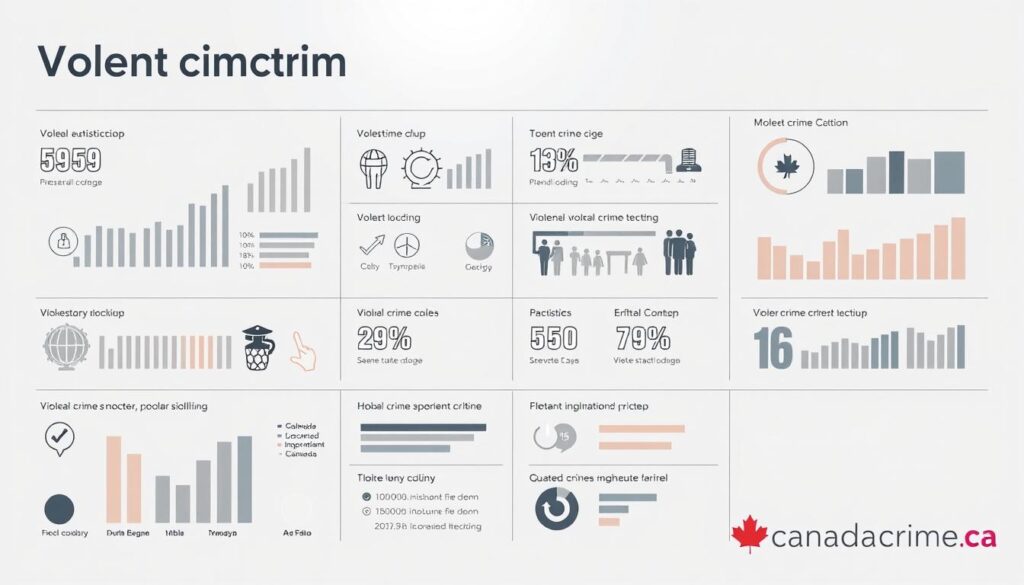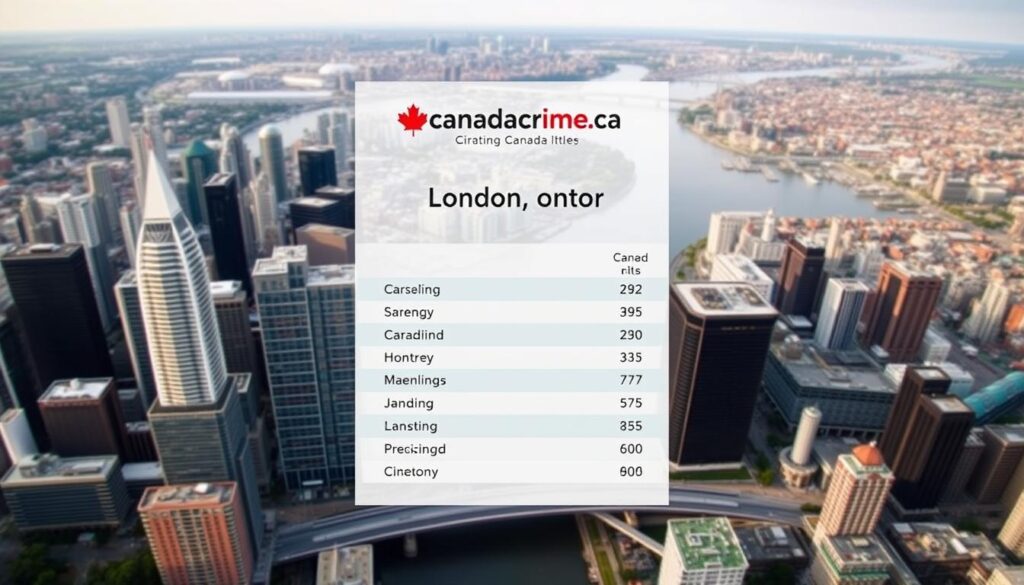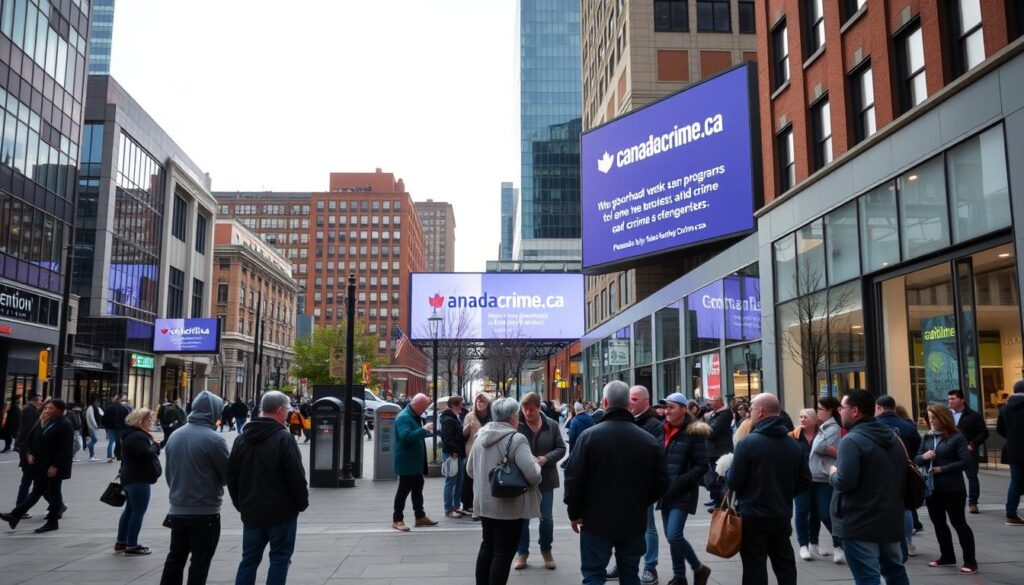Did you know that London, Ontario, ranks 9th among Canadian cities with the highest crime rates? Recent data reveals a complex picture of urban safety, with a Crime Index of 53.9 and a Safety Index of 46.1. This indicates growing concerns about property and drug-related crimes, despite the city’s reputation as a hub for education and culture.
The city’s crime landscape is a pressing concern for residents and visitors alike. Understanding the crime statistics and safety perceptions is crucial for addressing these concerns. This article provides a comprehensive overview of crime in London, Ontario, exploring various aspects of crime and safety.
Current Crime Situation in London, Ontario
London, Ontario, is experiencing a shift in its crime dynamics, with recent data showing a mix of positive and concerning trends. The city’s overall crime rate has seen a modest decrease, indicating some progress in safety improvements.
Crime Index and Safety Index
The crime index provides a comprehensive overview of the city’s crime statistics. London’s crime index is a reflection of its overall crime situation, taking into account various types of criminal activities. The safety index, on the other hand, measures how safe the city is perceived to be by its residents and visitors.
According to recent statistics, London has experienced a 2% decrease in overall crime rates year-over-year. This decrease is attributed to a 2.4% reduction in total crime incidents and a 4.4% decrease in property crime. However, there has been a concerning 4.3% increase in violent crime.
Year-over-Year Crime Trends
| Category | Year-over-Year Change |
|---|---|
| Total Crime Incidents | -2.4% |
| Property Crime | -4.4% |
| Violent Crime | +4.3% |
| Overall Crime Rate | -2% |
The divergent trends between property and violent crime require different approaches from law enforcement and community safety initiatives. The data indicates that while London is making progress in some areas, it faces growing challenges in others, particularly concerning violent offenses.

London Canada Crime Rate Compared to National Average
When evaluating the safety of London, Ontario, it’s crucial to examine its crime rate relative to the national average. This comparison provides valuable insights into the city’s safety and helps identify areas that may require additional attention from law enforcement and community leaders.
Total Crime Statistics
London’s overall crime rate is an important metric for understanding the city’s safety landscape. According to available crime statistics, London’s crime rate can be compared to the national average to gauge its relative safety. The total crime statistics encompass a wide range of criminal activities, from property crimes to violent offenses.
The data indicates that London faces challenges in maintaining a low crime rate compared to other Canadian cities. Understanding these statistics is essential for developing effective crime prevention strategies.
Violent Crime Statistics

London’s violent crime rate stands at 1,285 per 100,000 population, which is 23% higher than the national average of 1,042. This disparity indicates a significant safety concern, as residents have a 1 in 78 chance of becoming victims of violent crime. Violent crimes include serious offenses such as homicide, assault, robbery, and harassment.
The elevated rate of violent crime in London suggests that the city faces particular challenges with interpersonal violence, which may necessitate targeted intervention strategies to improve safety and reduce higher crime rates.
London’s Ranking Among Canadian Cities
London, Canada, faces a unique challenge in terms of crime rates when compared to similar Canadian cities. Understanding its position relative to other major urban centers in Canada is crucial for assessing its safety and identifying areas for improvement.
Position in National Crime Rankings
London’s crime profile is concerning when juxtaposed with other Canadian cities of comparable population sizes. The city’s total crime rate stands at 5,005 per 100,000, significantly higher than many of its counterparts.
Comparison with Similar-Sized Cities
When compared to cities with similar population sizes, London’s crime rate is notably higher. For instance, Laval, with a population of 445,050, reports a total crime rate of just 2,177 per 100,000, less than half of London’s rate.
| City | Population | Total Crime Rate per 100,000 |
|---|---|---|
| London | 383,822 | 5,005 |
| Laval | 445,050 | 2,177 |
| Markham | 359,111 | 2,599 |
| Vaughan | 321,974 | 2,123 |
| Quebec City | 548,244 | 2,520 |
These comparisons highlight that London faces unique challenges contributing to its elevated crime rates. Understanding these differences can help identify potential solutions based on successful approaches in similar communities, ultimately enhancing safety in London.

Types of Crime in London
London’s crime landscape includes a mix of violent and property crimes, each with its own trends and statistics. Understanding these different types of crime is essential for residents to be aware of the potential risks and take necessary precautions.
Violent Crime Breakdown
Violent crimes in London include offenses such as assault, robbery, and homicide. These crimes have a significant impact on the community, causing physical harm and emotional distress to victims and their families. According to the data, London’s violent crime rate is a concern for residents, although it is part of a broader national trend.
The clearance rate for violent crimes is generally higher than for property crimes, indicating that law enforcement is more effective in investigating and solving these cases.
Property Crime Analysis
Property crimes are a significant issue in London, with a rate of 3,720 per 100,000 population, exceeding both provincial and national averages. These crimes include breaking and entering, theft, motor vehicle theft, fraud, mischief, and other property violations.
| Type of Property Crime | Rate per 100,000 | Clearance Rate |
|---|---|---|
| Breaking and Entering | 500 | 20% |
| Theft | 2,000 | 25% |
| Motor Vehicle Theft | 800 | 15% |
The clearance rate for property crimes in London is only 22%, which is lower than both provincial and national averages. This indicates challenges in investigating and solving these crimes.

Crime Severity Index Explained
London’s crime landscape can be better understood through the lens of the Crime Severity Index (CSI), a statistical measure that weighs the severity of crimes. The CSI is a vital tool for assessing the crime situation in various regions.
How CSI is Calculated
The Crime Severity Index is calculated based on the number and severity of crimes reported to the police. It takes into account the violent and non-violent crimes, assigning weights to different types of offenses based on their perceived seriousness. This index provides a more nuanced view of crime rates by considering not just the volume of crimes, but also their severity.
London’s CSI Trends
London’s Crime Severity Index has shown a complex pattern in recent years. While the overall CSI has seen modest improvements, there are divergent trends in different crime categories. The violent CSI component has increased, aligning with a 4.3% rise in violent crime rates. Conversely, the non-violent CSI component has decreased, reflecting improvements in property crime rates. This mixed picture indicates that while overall crime volume may be decreasing slightly, the severity of remaining crimes may be increasing in certain categories.
| Crime Category | Trend | Percentage Change |
|---|---|---|
| Violent Crime | Increasing | +4.3% |
| Non-Violent Crime | Decreasing | -X% |
| Overall CSI | Fluctuating | +/-Y% |

Neighborhood Safety Map of London
The city’s crime map reveals significant variations in safety across different neighborhoods, providing valuable insights for residents and potential homebuyers.
London’s crime data indicates that certain areas experience higher crime rates, while others remain relatively safe.
High-Crime Areas
Some neighborhoods in London have higher concentrations of crime, often correlating with socioeconomic factors.
- These areas tend to have higher population densities and lower income levels.
- Crime rates can fluctuate significantly within these neighborhoods.
Safest Neighborhoods
In contrast, several neighborhoods in London are considered safe, with lower crime rates and a strong sense of community.
- These safer areas typically have lower population densities, higher income levels, and more stable housing.
- Nearby communities like Middlesex Centre, Zorra, and Thames Centre also offer lower crime rates for those willing to live outside the city limits.
Factors Contributing to London’s Crime Rate
Analyzing the factors behind London’s crime rate reveals a multifaceted problem that involves various socioeconomic and environmental elements. Understanding these factors is crucial for developing effective strategies to address crime and improve community safety.
Socioeconomic Factors
Socioeconomic factors play a significant role in shaping London’s crime landscape. Poverty, unemployment, and lack of education are among the key challenges that contribute to higher crime rates. These issues can lead to a cycle of disadvantage, making it more difficult for individuals to escape criminal behavior. For instance, individuals facing economic hardship may resort to property crimes to support themselves or their families. Addressing these underlying socioeconomic factors is essential for reducing crime and fostering a safer community.
- Lack of economic opportunities contributes to higher crime rates.
- Poor educational outcomes are linked to increased criminal activity.
- Social inequality exacerbates the crime problem.
Drug-Related Issues
Drug-related issues are another significant contributor to London’s crime rate. The city’s opioid crisis has intensified drug-related criminal activity, affecting both property and violent crime rates. Substance abuse leads to property crimes as individuals commit thefts and break-ins to support their addiction. Moreover, the drug trade generates violent crime through territorial disputes and conflicts between those involved in distribution. Effective addressing of drug-related crime requires a multifaceted approach, including harm reduction and treatment programs, alongside law enforcement efforts.

- Substance abuse is linked to property crimes and violent crimes.
- The opioid crisis has worsened drug-related criminal activity.
- Coordination between law enforcement, healthcare, and social services is necessary to address drug-related issues.
Law Enforcement Efforts in London
Law enforcement in London, Ontario, is a multifaceted effort involving various strategies and resources. The city’s police service is tasked with addressing a range of crime types, from violent offenses to property crimes.
Police Resources and Strategies
London’s law enforcement agency employs a variety of tactics to combat crime and enhance safety. These include community policing initiatives, intelligence-led policing, and collaborative efforts with other law enforcement agencies. The effectiveness of these efforts is crucial in maintaining public trust and reducing crime rates.
Clearance Rates and Effectiveness
The clearance rate is a key statistics indicator of law enforcement effectiveness. London’s overall weighted clearance rate stands at 31%, which is below both provincial and national averages. For violent crimes, the clearance rate is 58%, comparable to the national average. However, property crimes have a significantly lower clearance rate of 22%. The year-over-year decrease in clearance rates by 10.5% indicates growing challenges in solving crimes.
| Crime Type | Clearance Rate | Comparison |
|---|---|---|
| Overall | 31% | Below provincial (40%) and national (37%) averages |
| Violent Crimes | 58% | Comparable to national average, below provincial average |
| Property Crimes | 22% | Significantly lower than provincial and national averages |

Crime Prevention Initiatives
London’s approach to reducing crime involves a combination of community programs and public safety campaigns. These initiatives aim to educate and empower residents, enhancing overall community safety.
Community Programs
Community programs in London focus on engaging residents and fostering a collaborative approach to crime prevention. These programs include neighborhood watch initiatives, youth mentorship, and community policing. By building trust and cooperation between law enforcement and the community, these programs help to prevent crime and improve safety.
- Neighborhood watch programs
- Youth mentorship initiatives
- Community policing strategies
Public Safety Campaigns
London conducts various public safety campaigns to educate residents about crime prevention and personal safety. These campaigns provide information on securing property, avoiding victimization, and reporting suspicious activity. They utilize digital and social media platforms to reach diverse segments of the population.
| Campaign Focus | Objective |
|---|---|
| Home Security | Educate residents on securing homes and properties |
| Fraud Prevention | Inform residents about common scams and fraud tactics |
| Personal Safety | Provide tips on avoiding victimization and staying safe |

Understanding Crime Codes and Reporting
Understanding crime codes and reporting mechanisms is crucial for London residents to contribute to community safety. Effective crime reporting is a vital component of public safety in London, Canada, allowing law enforcement to allocate resources efficiently and address criminal activity.
How Crimes are Classified
Crimes in London are classified using a standardized coding system, which provides a crime detail that helps in understanding the nature of the offense. This classification is essential for maintaining accurate crime statistics and for law enforcement agencies to develop targeted strategies. The crime code is a critical element in this classification process, enabling the categorization of crimes into different types and severity levels.
Reporting Crime in London
London residents can report crimes through multiple channels, each designed for different situations. For crimes in progress, residents should call 911. For after-the-fact reporting, the non-emergency police line is available. Online reporting systems are also provided for certain types of incidents, such as minor thefts and vandalism. Additionally, Crime Stoppers offers an anonymous reporting option for those who wish to remain confidential. Proper reporting is essential for generating accurate crime statistics and informing resource allocation.

Safety Tips for London Residents and Visitors
London residents and visitors can enhance their safety by adopting simple yet effective crime prevention strategies. By being proactive, individuals can significantly reduce their risk of becoming victims of crime.
Personal Safety Measures
Personal safety is paramount in preventing crime. Being aware of one’s surroundings is crucial, especially in unfamiliar areas. Residents and visitors should avoid walking alone in dimly lit or isolated areas at night. Additionally, keeping personal belongings secure and being cautious with strangers can mitigate potential threats.
- Stay alert and aware of your surroundings.
- Avoid displaying signs of wealth (e.g., expensive jewelry or watches).
- Use well-lit and populated routes when walking at night.
Property Protection Strategies
Protecting property from crime involves several proactive measures. Securing homes with quality locks and alarm systems is a fundamental step. Moreover, not leaving valuables visible in vehicles and documenting valuable items can deter theft and aid in recovery if stolen.
- Install quality locks and consider an alarm system.
- Keep valuables out of sight from potential thieves.
- Record serial numbers of electronics and other valuable items.
Conclusion
London, Canada faces significant crime challenges, ranking 9th among Canadian cities with the highest crime rates. The city’s crime landscape is complex, with violent crime rates increasing while property crime has decreased. To address these challenges, coordinated efforts from law enforcement, community organizations, and residents are necessary. By understanding London’s specific crime patterns and contributing factors, more targeted prevention strategies can be developed. With a combination of enhanced enforcement and community-based initiatives, London can improve its safety profile and become a safer community for its residents.

